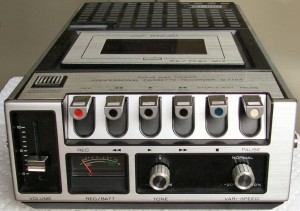Week 4 personal blog
Brad Kalbfeld, chief operating officer at Pacard Media Group LLC, spoke to my journalism class Thursday about the progression and implications of technology in journalism.
Technological progression
Kalbfeld began his lecture by showing the class his hefty bag of journalism equipment he had to carry around in the 1980’s. The bag included a typewriter, an audio recorder that uses cassette tapes, and a more portable recorder. In addition to these, Kalbfeld also had to use a number of other devices to send out his stories.
Eventually a new typewriter came out with a display screen that made it possible to edit stories and send them much easier. Now everything in Kalbfeld’s bag is available in the palm of your hand with smart phones.
Technological Implications
Kalbfeld also talked about the possible implications of such accessible technology that allows almost anyone to be a journalist. When anyone can be a journalist, they can skip most of the editing steps that many established journalism outlets use and post possibly false information. This means that credibility in journalism is becoming exponentially important as it gets harder to tell what is real and what is fabricated. Photoshop is making the truth increasingly hard to distinguish since people can make a picture show whatever they want.

Kalbfeld sees people growing tired of constantly having to distinguish truth from lies themselves and then returning to old-style newspaper. However, to gain back readers, newspapers will have to embrace new technology. Kaldfeld sees newspapers turning into large digital paper that is the same size and close to the same flexibility as a regular paper newspaper except it will be interactive. This will satisfy both the readers desire to get reliable information as well as their desire for technology.
